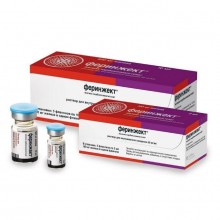



FERINJECT is an iron preparation in the form of a carboxymaltozate complex of a multicore iron (III) hydroxide. After parenteral administration, the macromolecular complex is captured by the reticuloendothelial system and decomposed into iron and carboxymaltose. Iron enters the bloodstream where it binds to transport protein transferrin. Iron in combination with transferrin is transferred to the cells of the body, where it is used to synthesize hemoglobin, myoglobin and a large number of enzymes or accumulates in the form of ferritin.
Iron deficiency anemia in the case when oral iron preparations are ineffective or cannot be used. The diagnosis must be confirmed by laboratory tests.
Active substance: Iron carboxymaltose
Excipients: sodium hydroxide / hydrochloric acid to pH 5.0–7.0; water for injection up to 1 ml.
No customer reviews for the moment.
IV - jet or drip and by introducing into the venous area dialysis system.
Before opening, the bottles should be inspected for possible sediment and damage. You can use only a homogeneous solution without sediment.
Drip introduction
You can not assign a drip of 20 ml of Ferinject more than 1 time per week.
May be administered intravenously in a drip in the maximum single dose of up to 20 ml of Ferinject (1000 mg of iron), which should not exceed 0.3 ml of Ferinject (15 mg of iron) per 1 kg of body weight or the calculated cumulative dose.
Jet injection
Ferinject can be administered intravenously, in a maximum single dose of up to 4 ml (200 mg of iron) per day, but not more than 3 times a week.
Dose calculation
The cumulative dose of the drug in mg of elemental iron, necessary to restore the level of hemoglobin (Hb) and replenish iron stores, is calculated individually in accordance with the general iron deficiency in the body using the formula:
Cumulative iron deficiency [mg] = body weight [kg] × (target Hb * - actual Hb) [g / dL] ** × 2.4 *** + iron storage depot [mg] ****
---------------------------------------------------------------------
* Target Hb with a body weight less than 35 kg = 13 g / dl (respectively 8.1 mmol / l). Target Hb with a body weight of 35 kg and more = 15 g / dl (respectively 9.3 mmol / l).
** To convert Hb [mM] to Hb [g / dl]: multiply Hb [mM] by a factor of 1.61145.
*** Coefficient 2.4 = 0.0034 × 0.07 × 10000, where:
0.0034 - hemoglobin iron content is approximately equal to 0.34%;
0.07 - blood volume is approximately equal to 7% of body weight;
10,000 - conversion factor: 1 g / dl = 10,000 mg / l.
**** Iron deposited with a body weight less than 35 kg = 15 mg / kg body weight; iron deposited with a body weight of 35 kg and more = 500 mg.
For patients ≤66 kg: the calculated cumulative dose of iron should be rounded down to the nearest 100 mg.
For patients> 66 kg: the calculated cumulative dose of iron should be rounded up to the nearest 100 mg.
With the subsequent need to maintain the target level of Hb and other laboratory indicators of iron reserves within acceptable limits, it is possible to continue treatment with the Ferinject drug in the minimum maintenance dose.
Maximum tolerated single dose
Adequate cumulative dose of the drug should be calculated for each patient individually and should not exceed the calculated one.
Hypersensitivity to any of the components of the drug.
Anemia not related to iron deficiency.
Symptoms of iron overload or iron disruption.
Pregnancy, I trimester.
Lactation period.
Children under 14 years old.
Any parenteral iron preparations should not be administered simultaneously with oral dosage forms of iron, since This reduces the absorption of iron from the gastrointestinal tract.